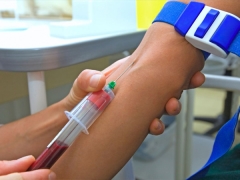How and why take blood from a vein in a child?
A blood test is very informative, so with such by analyzes baby can face from the first days of life. Routine diagnostic tests are usually taken from the finger, but often the child is also prescribed venous blood analysis. And it is only natural that mothers want to know whether a child needs to prick a vein and how it will be manipulated.
The reasons
Obtaining the blood of their child's veins is important for certain clinical studies that help identify diseases of the internal organs, exclude pathologies or specify treatment.
How is blood from a vein different from that taken from a finger?
First of all, they have different gas composition and different content of protein, trace elements, glucose, enzymes and other substances. Venous blood flows from the internal organs, so its analysis shows better how they work.
In addition, one of the advantages of selecting venous blood is the ability to immediately take a large amount of material for several tests. Get a lot of material from the baby finger does not work. The volume obtained from the finger is enough only to determine the cellular composition (for the KLA).
Recently, for the general analysis, they also began to frequently designate the taking of venous blood. This is a global modern practice, since when taking blood from a finger, a lot of intercellular fluid gets into it, which can affect its cells. In addition, the manipulation of the vein for a child is less traumatic and painful than a puncture of the finger.
Indications
The analysis of venous blood is prescribed in order to:
- Allergen Definitions. The analysis is prescribed in the presence of other manifestations of an allergic reaction in order to identify allergens and exclude their effects on the child.
- Detection of viral and parasitic diseases. Such analyzes are called serological. They are prescribed to confirm or exclude the presence of toxoplasmosis, mumps, measles, herpes, amebiasis and other diseases.
- Sugar determination. Determination of glucose in this analysis is more accurate, so if you suspect diabetes, the child will be sent to him.
- Biochemical analysis. This analysis is prescribed for severe diseases and suspected pathology of the liver or kidneys.
- Blood type definitions. Such an analysis is most often prescribed before blood transfusion and surgical treatment.
How to take?
For blood sampling use veins located:
- In the area of the elbow bend;
- On the forearm;
- On the back of the palm;
- On the head.
In these places, the child's veins are more visible, so it is easier to get into them with a needle. Most often, the manipulation is carried out with the vein of the elbow bend. The child’s handle is slightly tied up with a cord, the place of the future puncture is smeared with alcohol, then pierced with a needle and blood is collected. After removing the needle to the puncture site put a cotton swab and the baby's handle is bent at the elbow.
Training
First of all, mom needs to tune in to the procedure psychologically and not to worry, since her excitement will be given to the crumbs. If the child is over a year old, explain to him why it is necessary to take an analysis and what will happen. Are you worried that the little one will be hurt? Use anesthetic cream.
Going to the analysis, give the child a drink so that his blood is not too viscous. It is also recommended to warm the baby's hands before the procedure.
If you are asked to leave the office, while the baby takes blood, do not worry. This is sometimes practiced, so that the child is less worried and the health worker is more quickly coped with the manipulation. To divert the baby during the procedure will help a bright toy.
After the manipulation, give the child pleasant emotions - hug the baby, do some interesting work, for example, play or watch your favorite cartoon. Then the negative of the procedure will be quickly forgotten.













